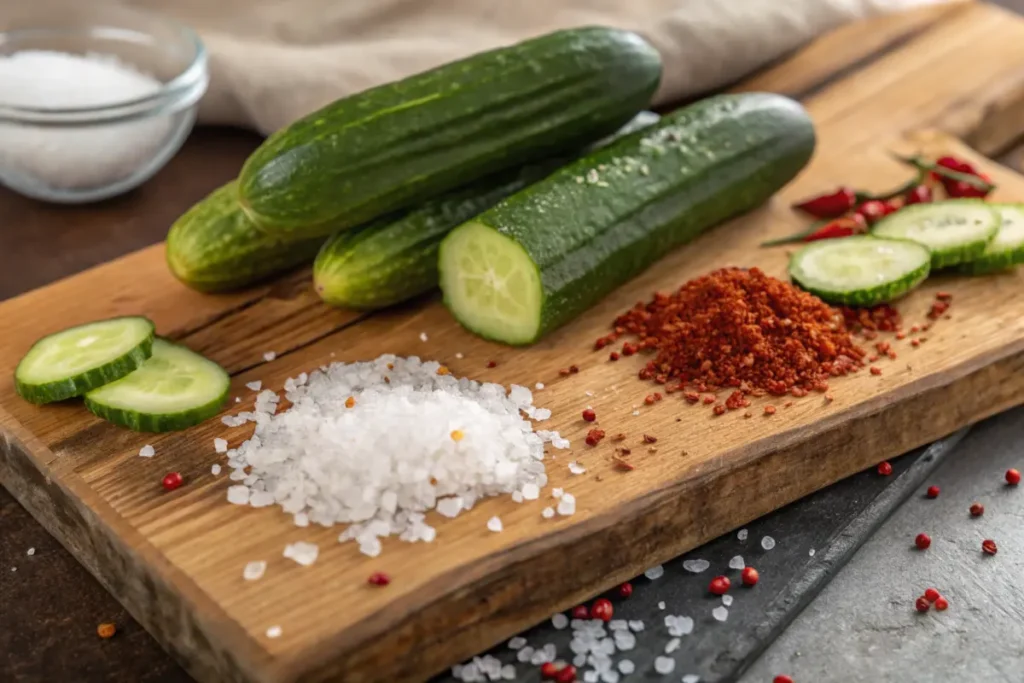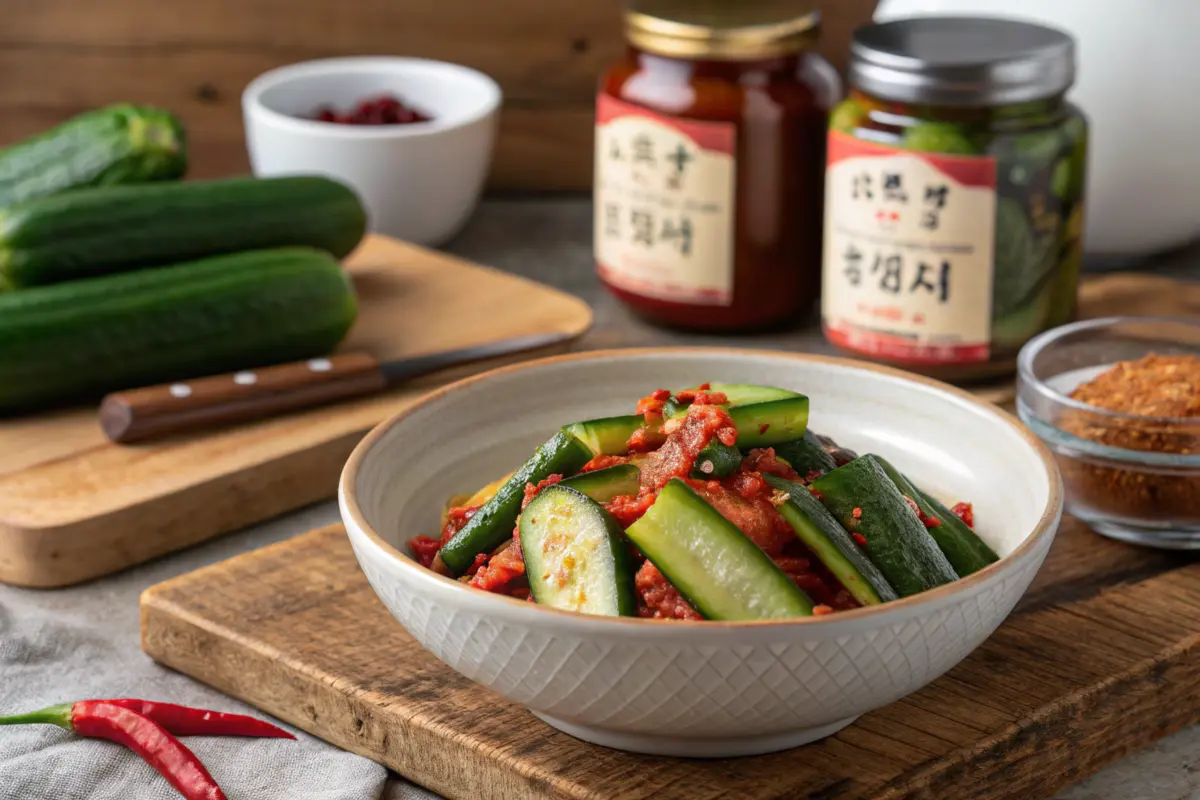Cucumber kimchi is a crisp, tangy twist on the classic Korean favorite, but getting it just right can be tricky. One common hurdle? Ending up with a dish that’s too watery. Excess liquid can dilute the bold flavors and turn your once-crunchy kimchi into a soggy disappointment. So, how do you tackle this issue? This article dives deep into how to make cucumber kimchi less watery, exploring tips, tricks, and troubleshooting methods to keep your dish deliciously balanced. Let’s start by understanding why watery kimchi happens in the first place.
Understanding Why Cucumber Kimchi Becomes Watery
The High Water Content of Cucumbers
Cucumbers are made up of nearly 95% water, which makes them wonderfully refreshing but tricky for kimchi. During fermentation, they naturally release this moisture, which can overwhelm the kimchi paste and thin out its consistency. It’s not just about the water, though—how you prepare cucumbers before fermentation plays a big role in managing their liquid content.
Common Mistakes in Preparation Leading to Watery Kimchi
When making cucumber kimchi, rushing through preparation steps can lead to trouble. Here are a few missteps to avoid:
- Skipping the salting step: Without proper salting, the cucumbers retain too much water.
- Using overly watery cucumbers: Some varieties like English cucumbers are more prone to releasing water.
- Overloading liquid ingredients in the paste: Ingredients like soy sauce or fish sauce can add unnecessary moisture if used excessively.
These mistakes make it challenging to keep the kimchi crisp and flavorful.
The Role of Fermentation in Releasing Water
Fermentation is the heart of kimchi-making, but it’s also where most of the excess water appears. As cucumbers ferment, their cell walls break down, releasing trapped moisture into the kimchi mixture. If this water isn’t controlled, it can pool at the bottom of the container, diluting the flavors. The key lies in balancing the fermentation process while minimizing liquid buildup.
Choosing the Right Ingredients for Less Watery Cucumber Kimchi

Best Cucumber Varieties for Kimchi
When it comes to making cucumber kimchi less watery, your choice of cucumber is crucial. Cucumbers with low water content, like Kirby cucumbers and Persian cucumbers, are ideal. Their firm texture helps maintain the crunchiness of the kimchi even after fermentation. On the other hand, avoid English cucumbers, as they tend to have higher water content and thin skins, leading to soggy results.
If you’re looking for additional tips on selecting cucumbers, check out the detailed breakdown on Which Cucumber Is Best for Kimchi?.
Essential Ingredients for Thick and Balanced Kimchi Paste
The kimchi paste plays a key role in preventing excess water. Start with traditional ingredients like Korean chili powder (gochugaru), garlic, and ginger, but ensure the paste isn’t overly liquid. Using grated vegetables like radish or carrots can add thickness while enhancing the flavor. Rice flour paste is another excellent thickener that binds the seasoning to the cucumbers.
For a full guide to preparing an authentic kimchi paste, see Cucumber Kimchi Recipe Guide.
Importance of Using Coarse Sea Salt
Coarse sea salt is a must for the salting process. It helps draw out excess moisture from the cucumbers without over-salting. Use about 2–3 tablespoons of coarse salt for every 2 pounds of cucumbers. This step is essential for achieving the perfect balance of crispness and flavor in your kimchi.
Step-by-Step Guide to Preparing Cucumber Kimchi
Properly Salting and Draining Cucumbers
Salting cucumbers properly is the foundation of how to make cucumber kimchi less watery. Here’s how to do it:
- Slice the cucumbers into uniform pieces for even salting.
- Sprinkle coarse sea salt generously over the pieces.
- Let them sit for 30 minutes to an hour, tossing occasionally.
- Rinse thoroughly to remove excess salt, then pat dry with a clean towel.
This process extracts excess moisture and prepares the cucumbers for fermentation.
Optimal Brining Time for Cucumber Cuts
The brining time varies depending on the size and thickness of your cucumber slices. Thin slices require 20–30 minutes, while whole or thicker cuts need 1–2 hours. Patience here ensures that most of the water content is drawn out before fermentation.
How to Create a Thick and Flavored Kimchi Paste
To make the paste:
- Mix Korean chili powder with garlic, ginger, and fish sauce or soy sauce.
- Add a rice flour slurry (rice flour cooked with water until thickened) for a creamy consistency.
- Grate radishes or carrots and mix them in to absorb any excess liquid.
This thick paste sticks to the cucumbers, ensuring even flavor distribution and reducing water pooling during fermentation.
Avoiding Overuse of Liquid Ingredients in the Paste
While ingredients like fish sauce and soy sauce are traditional, using them sparingly is key. Excess liquid in the paste can exacerbate the watery texture of your kimchi. A good rule of thumb is to use no more than 2 tablespoons per batch.
Fermentation Techniques to Prevent Watery Kimchi
Using Airtight Containers for Fermentation
Choosing the right container is critical when learning how to make cucumber kimchi less watery. Airtight containers, preferably glass or BPA-free plastic, work best. Here’s why:
- They maintain a consistent environment for fermentation, preventing external moisture from seeping in.
- They minimize air pockets that can cause uneven fermentation and excess liquid buildup.
When packing the cucumber kimchi, press it firmly into the container to remove any trapped air. Leave about 1–2 inches of space at the top to allow for expansion during fermentation.
If you’re curious about the role of containers in fermentation, Cucumber Kimchi Recipe Guide offers more insights.
Proper Temperature and Duration for Fermentation
Temperature directly affects the texture and water content of your kimchi. Ideally, ferment cucumber kimchi at a cool room temperature of 65–75°F (18–24°C) for 1–2 days. Afterward, move it to the refrigerator, where a steady temperature of 35–40°F (1.5–4.5°C) helps slow fermentation and reduce liquid release.
Keep the container away from direct sunlight or fluctuating temperatures, as these can disrupt the process and lead to watery results.
Fixing Watery Cucumber Kimchi After It’s Made

Draining Excess Liquid
Sometimes, even with the best preparation, cucumber kimchi can turn out watery. Don’t worry! One simple fix is to carefully drain the excess liquid. Tilt the container slightly and pour off the pooled water without disturbing the kimchi itself. This quick step can immediately improve the consistency and flavor.
Adding Thickeners Like Rice Flour Paste or Grated Vegetables
To restore balance, you can add a rice flour paste or grated vegetables like carrots or radishes. These not only absorb extra moisture but also enhance the kimchi’s texture and flavor.
Here’s how:
- Prepare a thick paste using rice flour and water.
- Gently fold it into the kimchi, ensuring even distribution.
- Let the kimchi rest for a few hours to absorb the liquid.
Compacting Kimchi into Smaller Containers
If your kimchi continues to release water, transfer it to a smaller, airtight container. This reduces the exposure to air, slowing down further liquid release. Compacting the contents tightly ensures even fermentation and helps maintain a firm texture.
For more delicious and helpful recipes, explore the variety of tips available on Recipe Foodies.
Creative Ways to Serve Cucumber Kimchi
Pairing Cucumber Kimchi with Traditional Korean Dishes
Cucumber kimchi isn’t just a flavorful side; it’s a versatile complement to many Korean meals. Its crisp texture and tangy taste pair beautifully with dishes like:
- Steamed Rice: A classic combination that balances the spicy kick of kimchi.
- Korean Barbecue: Serve it alongside grilled meats like bulgogi or galbi for a refreshing contrast.
- Hearty Soups: Add a spoonful of cucumber kimchi to dishes like doenjang jjigae (soybean paste stew) or kimchi jjigae for extra flavor.
These traditional pairings showcase the versatility of cucumber kimchi while highlighting its unique crunch.
Innovative Uses in Fusion Cuisine
Take cucumber kimchi beyond its traditional roots with these creative ideas:
- Tacos and Wraps: Use it as a spicy topping for fish or pork tacos.
- Salads: Chop the kimchi finely and toss it with greens, sesame oil, and a touch of soy sauce for an Asian-inspired salad.
- Burgers and Sandwiches: Add cucumber kimchi to burgers or pulled pork sandwiches for a tangy twist.
These fusion recipes make cucumber kimchi a star ingredient in modern cuisine. For more inspiration, try experimenting with different textures and flavor combinations.
FAQs About Making Cucumber Kimchi Less Watery
Why Does Cucumber Kimchi Become Watery?
The high water content of cucumbers, combined with improper preparation or fermentation techniques, often results in watery kimchi. Salting cucumbers inadequately or overloading liquid ingredients in the paste can exacerbate the issue. Mastering how to make cucumber kimchi less watery involves addressing these common pitfalls.
How Can I Fix Watery Kimchi Quickly?
If your kimchi turns out watery, don’t fret. Here’s what you can do:
1.Drain any excess liquid from the container carefully.
2.Add a rice flour paste or grated vegetables to thicken the mixture.
3.Store the kimchi in a smaller, airtight container to reduce further liquid release.
These quick fixes can save your kimchi and restore its bold flavors.
Which Cucumbers Work Best for Kimchi?
For crisp and less watery kimchi, choose cucumbers with lower water content like Kirby cucumbers or Persian cucumbers. Avoid English cucumbers, as their thin skins and high moisture levels often lead to soggy results.
Is It Necessary to Salt Cucumbers Before Fermentation?
Yes, salting is a vital step to draw out excess moisture and ensure the cucumbers remain firm during fermentation. Skipping this step almost always leads to watery and bland kimchi.
By addressing these common questions, you’re now well-equipped to troubleshoot and perfect your cucumber kimchi. Whether you’re sticking to traditional recipes or exploring modern twists, mastering these techniques ensures delicious results every time!
Common Mistakes to Avoid When Making Cucumber Kimchi
Skipping the Salting Process
Salting is one of the most important steps in making cucumber kimchi. Skipping or rushing through this process can lead to watery results. The salt helps draw out excess moisture from the cucumbers, ensuring they stay crisp during fermentation. Without proper salting, you might find yourself wondering how to make cucumber kimchi less watery after the fact. Always let the cucumbers sit with salt for at least 30 minutes and ensure they’re evenly coated.
Using the Wrong Cucumber Variety
Not all cucumbers are created equal when it comes to kimchi. Varieties like Kirby and Persian cucumbers are ideal due to their lower water content and firm texture. On the other hand, English cucumbers, with their thin skin and high moisture levels, often result in soggy kimchi. Choosing the right type of cucumber can significantly reduce the chances of excess water in your dish.
Adding Too Much Liquid to the Paste
Overloading the paste with watery ingredients like soy sauce or fish sauce can be a recipe for disaster. While these add flavor, using them in excess increases the liquid content of your kimchi. Stick to the recommended amounts and use thickeners like rice flour paste to keep the consistency balanced.
Over-Fermenting the Kimchi
Fermenting cucumber kimchi for too long, especially at room temperature, can lead to a mushy texture and excess water. Keep a close eye on your kimchi and transfer it to the refrigerator after 1–2 days to slow the fermentation process.
Tips for Consistently Great Cucumber Kimchi
Perfecting Your Preparation Process
To ensure your cucumber kimchi turns out just right every time, focus on the basics:
- Proper Salting: Don’t rush. Allow cucumbers to release as much water as possible before fermentation.
- Balanced Paste: Create a thick and cohesive paste by blending ingredients well and avoiding excess liquid.
- Choosing the Right Cucumbers: Stick to firm, low-water-content cucumbers for the best results.
Mastering these steps minimizes the risk of excess water and keeps your kimchi flavorful.
Monitoring Fermentation Carefully
Consistently great cucumber kimchi requires careful monitoring during fermentation. Here’s how:
- Use airtight containers to maintain a controlled environment.
- Check the kimchi daily for signs of excess liquid and adjust if needed by draining or compacting.
- Store at the right temperature to prevent over-fermentation and preserve its crunch.
Learning From Past Batches
Every batch of kimchi teaches you something new. If you’ve struggled with watery kimchi before, reflect on your process. Was the paste too thin? Were the cucumbers not salted properly? By learning from these experiences, you’ll become confident in mastering how to make cucumber kimchi less watery.
With these tips and a bit of practice, you’ll consistently create delicious, crisp cucumber kimchi that’s balanced and flavorful. The key is attention to detail and a willingness to refine your technique over time. Happy kimchi-making!
Conclusion
Mastering how to make cucumber kimchi less watery is all about preparation, balance, and attention to detail. From selecting the right cucumber varieties to salting them thoroughly and creating a thick, flavorful paste, each step plays a critical role in achieving the perfect texture and taste. By carefully monitoring fermentation and addressing common mistakes, you can consistently produce kimchi that’s crisp, vibrant, and packed with bold flavors.
Whether you’re new to kimchi-making or looking to refine your technique, these tips and tricks ensure that watery cucumber kimchi becomes a thing of the past. Experiment with traditional pairings or try your hand at creative recipes to make this dish a versatile staple in your kitchen. With practice and patience, your homemade cucumber kimchi will shine every time—delicious, refreshing, and perfectly balanced. Happy fermenting!

